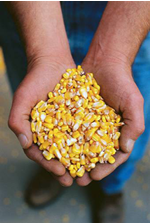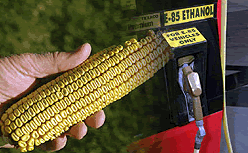Ethanol is a high-octane fuel that works well in internal combustion engines.

Ethanol is also known as ethyl alcohol, grain alcohol, and EtOH. It is a clear, colorless liquid and is made of the same chemical compound – and it is the same renewable biofuel – whether it is produced from starch- and sugar-based feedstocks such as corn grain (as it primarily is in the United States) and sugar cane (as it primarily is in Brazil) or from cellulosic feedstocks.
Ethanol is a high-octane fuel that works well in internal combustion engines. Octane helps prevent engine knocking and is extremely important in engines designed to operate at a higher compression ratio to generate more power, such as those found in many high-performance vehicles. Low-level blends of ethanol, such as E10 (10% ethanol, 90% gasoline), generally have a higher octane rating than unleaded gasoline. Low-octane gasoline can be blended with 10% ethanol to attain the standard 87 octane requirement. Ethanol is the main component in E85, a high-level blend of 85% ethanol and 15% gasoline. A gallon of pure ethanol (E100) contains 34% less energy than a gallon of gasoline.
Making ethanol from cellulosic feedstocks – such as grasses, trees, crop and forestry residues, and municipal wastes (e.g., old newspapers) – is more challenging than using starch or sugars. These materials must first be broken down into their component sugars for subsequent fermentation to ethanol in a process called biochemical conversion. Cellulosic feedstocks also can be converted into ethanol using heat and chemicals in a process called thermochemical conversion.
 However, cellulosic feedstocks have many advantages over starch- and sugar-based feedstocks. They are much more abundant and thus can be used to produce more substantial amounts of ethanol to meet U.S. fuel demand. They are waste products or, in the case of trees and grasses grown specifically for ethanol production, can be grown on marginal lands not suitable for other crops. Less fossil fuel energy is required to grow/collect them and convert them to ethanol and they are not human food products. Cellulosic ethanol conversion processes are a major focus of U.S. Department of Energy research.
However, cellulosic feedstocks have many advantages over starch- and sugar-based feedstocks. They are much more abundant and thus can be used to produce more substantial amounts of ethanol to meet U.S. fuel demand. They are waste products or, in the case of trees and grasses grown specifically for ethanol production, can be grown on marginal lands not suitable for other crops. Less fossil fuel energy is required to grow/collect them and convert them to ethanol and they are not human food products. Cellulosic ethanol conversion processes are a major focus of U.S. Department of Energy research.
Ethanol Distribution
Like other alternative fuels, ethanol producers face unique distribution challenges. Most ethanol plants are concentrated in the Midwest United States, but gasoline consumption is highest along the East and West Coasts. The volume of ethanol currently used in transportation is relatively small compared with the gasoline market. The ethanol produced generally can be absorbed in local or regional markets as E10 or E85, providing benefits to those markets. However, as ethanol production increases nationwide, distribution will become a more critical issue.

Most ethanol plants distribute their fuel by truck and rail. Some larger plants are located near navigable waterways and can ship their ethanol by barge, which is a more economical option. The least expensive ethanol distribution option would be by pipeline – the way most gasoline is shipped. However, there are issues preventing the use of pipeline transport. First, water has an affinity for ethanol, so much greater care would have to be taken to keep water out of the pipeline. Next, ethanol is a better solvent than gasoline, so initial shipments in a previously existing pipeline could pick up many impurities that had accumulated in the pipeline. In addition, ethanol's corrosiveness could shorten a pipeline's lifetime.
Pipeline location is also a challenge. In general, gasoline pipelines start in the South, near petroleum refineries. Because most ethanol is produced in the Midwest, the current pipeline system is not conducive to transporting the alternative fuel.
Because ethanol transportation by pipeline is not widespread, it is generally blended at the local wholesale terminal for use as E10 or E85. Use of E10 or other low-level blends is generally based on local air-quality regulations or federal and state renewable fuel standards. E85 is typically purchased by fuel station owners who have chosen to sell it to consumers, or by federal, state, and private fleets that are using E85 in their flexible-fuel vehicles.
The landscape is slowly changing with the announcement that Kinder Morgan is now transporting fuel grade ethanol batched with gasoline from Tampa to Orlando, FL. Ethanol is blended with gasoline at the Orlando facility and then shipped via truck to gas stations and for the central Florida consumer.
PHMSA Related Research & Development:
For information on PHMSA R&D related to ethanol, please visit https://primis.phmsa.dot.gov/rd/matrix/search/ and the filter the Contract ID and Title column for “Ethanol”. This will itemize all related projects.
Sources of Information:
- Energy Information Administration: Review of Transportation Issues and Comparison of Infrastructure Costs for a Renewable Fuels Standard
- Safe & Reliable Ethanol Transportation & Storage Technology Roadmapping Workshop - October 2007
- United States Department of Energy, Energy Efficiency and Renewable Energy (Ethanol)
